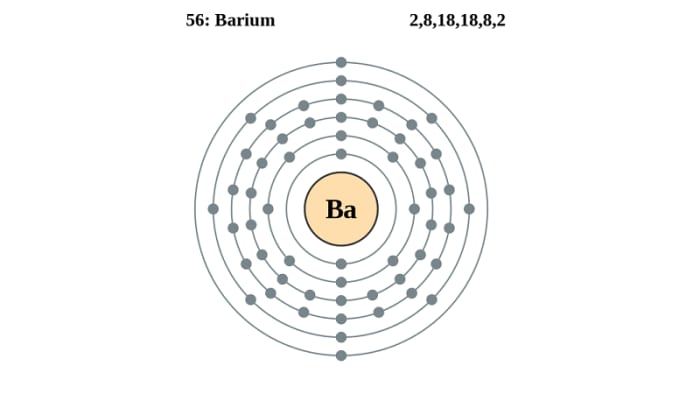Properties of barium
All important properties of barium and its compounds

Barium is an element of the second group of the 6ᵗʰ period of the periodic table. It is an alkaline earth metal. In nature it is primarily encountered in the form of minerals – the most important of natural compounds of barium are barite, BaSO₄ and witherite BaCO₃. Barium alumosilicates, nitrates etc. are much more rarely encountered.
In nature it is encountered in the form of seven stable isotopes (substances with an identical atomic number, but different mass numbers) with the mass numbers 132, 134, 135, 136, 137, 138 (the last is the most common). The most abundant radioactive isotope of barium has a mass number of 130 (the radioactivity of the isotope is low).

Physical properties
By its appearance, barium, like all metals of its subgroup, is a soft silvery-white malleable metal. It has high conductivity and chemical reactivity.
Owing to its reactivity, barium is not stored in air – the metal is covered with a layer of kerosene or paraffin.
Obtaining barium
The pure metal without impurities can be obtained by electrolysis of a flux of salt – for example barium chloride:
К(-): Ba²⁺ + 2е = Ba⁰;
A(+): 2Сl⁻ - 2е = Сl₂;
BaСl₂ = Ва + Cl₂.
Barium can also be obtained by the aluminothermic method, reducing it from the oxide with metallic aluminum:
3BaO + 2Al = 3Ba + Al₂O₃ (the reaction takes place in a vacuum at a temperature of 1200-1250 ᵒC or 2192-2282 ᵒF).

Barium oxide is obtained for conducting this reaction from the barite concentrate of the mineral BaSO₄ by the following reactions (all reactions take place with heating):
-
BaSO₄ + 4C = BaS + 4CO;
-
BaS + 2H₂O = Ba(OH)₂ + H₂S (with heating, the hydrolysis of salt takes place more intensively);
-
Ba(OH)₂ = BaO + H₂O (heating at 800 ᵒC (1472 ᵒF) makes it possible to break down barium hydroxide Ba(OH)₂ to barium oxide BaO and water).
In the last reaction, in the flow of air not only the main oxide BaO can be obtained, but also barium peroxide BaO₂.

Chemical properties of barium
Barium is no less reactive than alkaline metals such as sodium or potassium. When heated in air, the metal may ignite, and on contact with oxygen, it may oxidize to barium oxide BaO (in air barium nitride Ba₃N₂ may also form).
Barium reacts energetically with water with the formation of a base (barium hydroxide) and hydrogen:
Ba + 2H₂O = Ba(OH)₂ + H₂.
With non-metals, the metal reacts with the formation of salts:
-
Ba + H₂ = BaH₂ (with heating barium hydride forms);
-
Ba + S = BaS (barium sulfide is formed from simple substances with heating);
-
Ba + Br₂ = BaBr₂ (the metal reacts with any halogens with the formation of halogenides – in this case barium bromide forms);

- 3Ba + 2P = Ba₃P₂ (with heating with phosphorus, barium phosphide forms).
Barium reacts energetically with diluted acids, and with heating also with ammonia:
-
Ba + 2HCl = BaCl₂ + H₂;
-
6Ba + 2NH₃ = 3BaH₂ + Ba₃N₂ (barium hydride and nitride form).
Click here for the experiment where ammonia fountain forms.
When it reacts with nitric acid of different concentrations, barium nitrate and various other products of reaction form:
-
4Ba + 10HNO₃ = 4Ba(NO₃)₂ + NH₄NO₃ + 3H₂O (if the acid is heavily diluted);
-
4Ba + 10HNO₃ = 4Ba(NO₃)₂ + N₂O + 5H₂O (if the concentration of acid is high).

If the acid is of medium concentration, besides barium nitrate and water, molecular nitrogen may be released.
Barium oxide and hydroxide (BaO, Ba(OH)₂) have typical base properties – for example they react with acids and acidic oxides:
-
BaO + CO₂ = BaCO₃;
-
Ba(OH)₂ + CO₂ = BaCO₃ + H₂O;
-
BaO + 2HCl = BaCl₂ + H₂O;
-
Ba(OH)₂ + 2HCl = BaCl₂ + 2H₂O.
When barium hydroxide is heated up to 800 ᵒC (or 1472 ᵒF), it breaks down to oxide and water, while barium oxide is capable of reacting with water with the formation of hydroxide:
-
Ba(OH)₂ = BaO + H₂O;
-
BaO + H₂O = Ba(OH)₂.

Qualitative reactions for the barium ion
Barium can be distinguished from other metals with similar physical and chemical properties by the color of the flame and the reaction with sulfate ions (Ba²⁺ + SO₄²⁻ = BaSO₄).
Barium salt changes color in a flame – it becomes yellowy-green. This takes place because of the barium ions present in the qualitative composition of the salt.
The presence of barium ions in a salt can also be detected by an exchange reaction – for example barium chloride with sodium sulfate:
BaCl₂ + Na₂SO₄ = BaSО₄ + NaCl (the reaction takes place as among the products of reaction is the sediment BaSO₄). Barium sulfate is a white milky sediment which does not dissolve in acids.
Also from neutral barium salts (for example BaCl₂), in the reaction in sodium rhodizonate Na₂C₆O₆, barium rhodizonate BaC₆O₆ of a reddish-brown color forms. The reaction is quite sensitive and makes it possible to detect barium ions in small concentrations.
Barium salts have found wide application in industry – electrical parts are made from barium titanate BaTiO₃, and barium sulfate BaSO₄ is used in medicine for diagnosing gastrointestinal diseases.